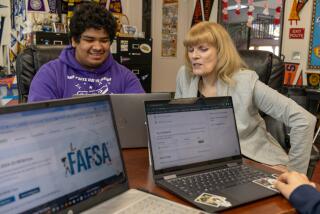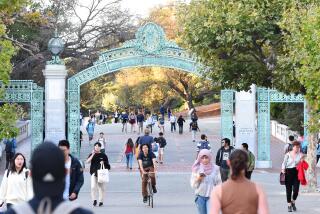More schools opening Advanced Placement courses to all students
Alex Wong, a junior at Mark Keppel High School in Alhambra, is working hard for admission to an elite college. His resume boasts nearly straight A’s in rigorous classes, a summer program experience at Stanford University, an Eagle Scout project, club soccer, school choir.
But his steady progress hit an unexpected roadblock this year. Aiming to open access to college-level Advanced Placement courses, the school switched to a computer-based lottery to distribute spaces. Alex initially got shut out of all three courses he requested.
The new system caused an uproar among families whose children failed to get into AP courses, which many consider critical to develop advanced skills, boost grade-point averages and allow students to earn college credit, saving tuition dollars. They plied administrators with complaints, circulated a petition and launched a Facebook group to swap classes.
“IM DESPERATE ILL GIVE YOU FREE FOOD,” one student, Kirk Hum, posted on the 210-member AP Flea Market Facebook group.
Long considered an elite track for the most talented and ambitious students, AP classes are now seen as beneficial for any students willing to push themselves — and schools are increasingly viewing access to them as a basic educational right. But that has come with challenges and controversy.
Downtown Magnets High School in Los Angeles has nearly doubled participation in AP classes over the last five years — publicizing their pros and cons through an annual, two-week informational campaign for students and parents. Those who enroll are not necessarily top students — but the school reports benefits for them nonetheless.
Miracle Vitangcol, a Downtown Magnets junior with average grades and test scores, is failing her AP U.S. history class; she said she is overwhelmed by the rapid pace and volume of material she needs to memorize. But she said she intends to stick it out because the class is teaching her to manage her time, take good notes and develop perseverance.
“I’m struggling to adjust,” she said. “But I keep telling myself, ‘It’s OK. You can do it. Just push yourself.’ ”
Some critics worry that the open-access movement is pushing too many unprepared students into AP classes, as indicated by higher exam failure rates over the last decade and a persistent achievement gap among races. They also fear that open enrollment policies are prompting teachers to weaken courses and inflate grades.
“While expanding access is generally a good thing, we need to make sure we’re not watering down the experience for the high achievers,” said Michael Petrilli, executive vice president of the Thomas B. Fordham Institute, a Washington-based educational policy organization.
But the College Board, which runs the AP program and is encouraging open access, said the effort has generally been successful. Even though national participation has doubled in the last decade to 2.1 million students last year, exam failure rates have increased only slightly, officials said. Passing scores have outpaced failing results by nearly 20% over the last decade.
At the same time, access to AP courses remains uneven. Low-income students are twice as likely as others to attend schools without a full array of AP courses, according to a June study by the Education Trust and Equal Opportunity Schools. Such disparities prompted a 2011 California law that encourages schools to offer AP courses in at least five subjects.
Downtown Magnets, whose students are overwhelmingly low-income, offers 15 different AP courses. And the school’s 61% exam pass rate far outpaces L.A. Unified’s average of 40%.
Teachers are one reason behind the school’s success, said Lynda McGee, the school’s college counselor and AP coordinator. In Daniel Jocz’s AP U.S. history class, for instance, about 90% of students pass the exam compared with the national rate of about 54%.
During a recent visit, Jocz enlivened an otherwise dry lesson on Henry Clay’s “American System” national economic plan with music clips from Bruce Springsteen and Queen, seemingly odd juxtapositions with TV characters Gumby and Pokey and amusing factoids about the Erie Canal. He flagged content likely to appear on the AP exam, such as the Tariff of 1816, and directed students to work in groups on an AP-type essay question about the contributions of Thomas Jefferson.
Jocz sees both pros and cons of open access. “The good thing is giving people the chance to challenge themselves ... but some kids are not ready, and are we setting them up for failure?” he said.
At Jordan High School in Watts, Evan Dvorak confronted that question head-on last year when he allowed any student to take his AP physics class. But he found that those who had not acquired the necessary calculus skills could not handle the work; all 20 students failed the exam.
“As a teacher, you want to think you can reach every student and perform miracles to get them where they need to be,” he said. “But it proved to be too much for everyone.”
This year, Dvorak made sure that students knew how difficult the course was; only six have enrolled and are doing much better, he said.
Overall, L.A. Unified has increased AP participation to 17.7% of high school students this year from 12.5% in 2009, when it adopted a districtwide open-enrollment policy. The exam pass rate has stayed about the same, at 40%, although it varies from 62.4% for whites to 25.7% for African Americans.
The district has received more than $1 million in federal funds to support students and give teachers in 20 schools the AP training required by the College Board.
Long Beach Unified opened its AP classes a decade ago; the district has boosted the percentage of students taking the spring exams to 21% of its sophomores, juniors and seniors this year, from 10% in 2003. Latinos have shown the greatest growth, increasing to 41% of test-takers from 29% during that time period. The exam pass rate has remained steady at 54%.
“We’re preparing more students for college and helping parents in the pocketbook when it comes time for college tuition,” said Long Beach Unified spokesman Chris Eftychiou.
At Keppel, some parents whose children were shut out of AP classes say they support the goal of open access — but not the random selection for limited spaces.
“It’s a delicate balancing act,” said Shelly Tan, whose son, Douglas, failed to get into an AP biology class after doing the summer work during a family vacation. “Yes, you want to give all kids opportunity — but not at the expense of kids who can do the honors work.”
Until last year, Keppel used grades and test scores to determine placement — factors also used by Downtown Magnets for over-enrolled classes. But Keppel Principal Jacinth Cisneros, who arrived last year, said she believed that process violated Alhambra Unified’s equal-access policy, adopted in 2007. As a result, she launched the computerized selection this year.
“I believe every child has the opportunity to redirect their path at any point during their high school career,” she said.
Cisneros said the school has since added another AP English class but could not offer more because it did not have enough trained teachers.
That has left many Keppel students stranded. Alex Wong eventually got into AP environmental science, a course he considers critical to his plans to apply for early admission to Stanford as an environmental engineering major. But he remains shut out of AP English and AP calculus and will have to try again next year.
Some students say they plan to study the AP course work with a tutor and take the exam anyway. Keppel junior Andre Liu has enrolled in an eight-month AP English course to prepare him for the May exam. The cost: $4,000.
More to Read
Start your day right
Sign up for Essential California for news, features and recommendations from the L.A. Times and beyond in your inbox six days a week.
You may occasionally receive promotional content from the Los Angeles Times.







